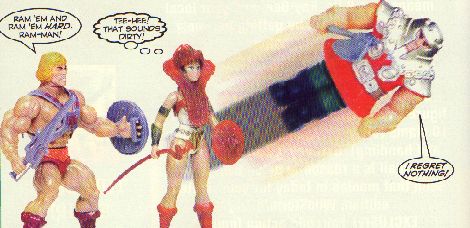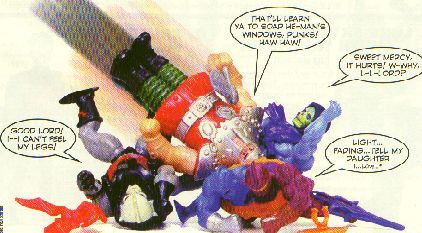



They were masters of their domain.
Over the past 12 months, we've examined a passel of action figure franchises in the pages of "Toy Story," ranging from the successful to the imitative, from the awesome to the merely adequate. This issue it's time to look at one of the true biggies, a toy line with an impact on the action figure industry that can still be seen today.
That's right, it's He-Man time...and to celebrate, we've given good Prince Adam and company a few extra pages to tell their story.
Without a doubt, Mattel's Masters of the Universe franchise was one of the most influential action figure lines of the past 15 years. Thanks in large part to "He-Man and the Masters of the Universe," an animated series based on the toys, Masters was an unprecedented success. He-Man also capitalized heavily on so-called "action features" which gave each toy a built-in special, unique function. These two elements would be a major part of toy lines that followed, including Transformers, Teenage Mutant Ninja Turtles, Super Powers, and many, many more. In his favor, He-Man took the mechanisms to new levels. Kids got a new gimmick in every single He-Man toy.
It all started a little less than 30 years ago. In 1969, a landmark decision by the Federal Communications Commission drastically affected the American toy industry. In the late 1960's, Mattel was primed to capitalize on "Hot Wheels," an animated show based upon its toy car franchise. Critics charged that the show was really just a glorified commercial for the immensely popular toys, and efforts were made to keep the series off the air. At first, the attempts to forestall it failed. When "Hot Wheels" finally did air, the FCC stepped in and made it illegal to create a children's television show based primarily on a toy, and therefore deemed lacking of necessary educational value. Fortunately, the decision didn't really affect too many animated series or toy lines out there at the time. It was an important moment in toy history, not for the ban, but for the edict's reversal in 1983, a moment that changed toys forever. Ironically, one of the first toy franchises affected was Mattel's He-Man.
Two years earlier, in 1981, Mattel kept a watchful eye out for its next big hit. Martin Arriola, now a senior staff designer with Mattel, was a designer on Masters for most of its initial six-year run. He remembers that the company was performing market research into doing figures based on Robert E. Howard's popular Conan the Barbarian character. Renderings of the Cimmerian warlord were created, one of which was by staff artist Mark Taylor. Arriola saw that what Taylor was creating was just a little bit different. "It was Conan-like," Arriola says, "but he had blond hair instead of dark. We also had renderings for Skeletor and Beast Man."
Though Arriola won't swear this is exactly how it went down, to the best of his knowledge these drawings were added into the market research already being performed for a potential Conan line. Faced with a choice between Conan and He-Man, more kids chose He-Man.
Betting squarely on this new franchise, Mattel then created a backstory for the character and released the first figures to the market in 1981, each with its own mini-comic. "[He-Man's]original storyline was a lot different than what they did in the animation," recalls David Wolfram, now a design manager at Mattel, who designed He-Man toys during their last years on the market. "He was a lot more of a barbarian in the beginning, and it was a lot more sword-and-sorcery oriented." The Conan inspiration was shining through.
Near Christmas 1983 the FCC reversed its 1969 decision, stating that the original legislation had been too broad. Initially, the FCC feared that cartoons would become product advertisements only, not realizing that a toy-based animated series could still have intrinsic story value beyond the commercial appeal. Moving forward, individual TV stations would have to show a certain amount of educational programming to counterweight the toy-based programming. a necessary concession for the FCC.
The field was now wide open. Although it's not clear who approached whom first, cartoon maker Filmation or Mattel, a deal was quickly reached to create He-Man cartoons. Animators worked fast, and "He-Man and the Masters of the Universe" debuted in 1984. The new cartoon was less a barbarian story and more a superhero tale: Whenever danger threatened the land of Eternia (usually in the form of the arch-villain, Skeletor), meek (yet strangely muscular) Prince Adam would run off with his pet cat, Cringer, spout the phrase "By the power of Grayskull!" and the two would be transformed into the heroic He-Man and Battlecat, respectively. Two seasons of 65 episodes each were created, and the show ran for several years. It's also worth noting that Paul Dini (of animated "Batman" and "Superman" fame) and J. Michael Straczynski (creator of "Babylon 5") were involved with "He-Man" and wrote several episodes each.
Mattel relaunched the figures in 1984 with great success. "He-Man" soared to the top of the ratings, and Mattel sold in excess of 55 million figures worldwide in 1984 alone. It brought Mattel, which had posted losses for the previous five quarters (due in large part to products like the failed Intellivision video game system) out of the red and into the black. In fact, Mattel then boasted a 51 percent gain in sales, thanks mostly to He-Man. At its height in 1985, the line brought in a $450 million profit for Mattel and is rumored to have grossed over $1 billion during its entire run.
Also in 1984, He-Man broke new ground in another way. Arriola notes that the action figures prior to that date were pretty basic, lacking the action features that would make them so notable one day. "When they first started, [the figures] were very simple," Arriola says. "We had to start goosing up what the characters did because we wanted to keep the line going." Someone on the team then suggested that the designers should look to an older Mattel toy franchise: The 9-inch Big Jim, which had been Mattel's answer to competitor Hasbro's mega-popular G.I. Joe in the early 1970s. Big Jim had incorporated many action features, such as the character's classic karate chopping arms. So it came to pass that Battle Armor He-Man and his nemesis, Battle Armor Skeletor, made their debut with rotating torsos which unleashed power punches, the first in a long string of action features. Obviously, action features were not new, but this was the first time they were implemented on every single figure in the line.
Wolfram remembers how the figures were created. "We had a prelim group and then a design group," he says. "The prelim group would come up with mechanisms and concepts, and then we would design toys around those [concepts]. Plus they brought in a lot of different features from outside inventors. My thing was trying to incorporate and make some of those different things work. That was as much of a chore as actually just coming up with the concepts themselves. It was our responsibility to make a product that would look good and function as well."
According to Wolfram, this was more of a challenge than it might first appear, because sometimes the prelim group let themselves get a bit carried away. "They'd promise all these great features that [the figures] would do, and there's no way they could ever do them. So we had to go back and try to give some reality to their ideas. Sometimes we'd actually design [their ideas] just to show them how bad they would actually look or work. They'd fall in love with their ideas without any thought to cost, safety or practicality."
The popularity of the He-Man toys inspired Mattel to try to duplicate its success with She-Ra, Princess of Power. Filmation debuted the new "She-Ra" cartoon in 1985, and Mattel released three series of figures as well. Neither the cartoon, which was set in the same universe as He-Man, nor the figures achieved anywhere close to He-Man's success. In 1986, Filmation and Mattel tried again by creating "Bravestar"--a completely unrelated property--as an animated cartoon and action figure line. Both failed and lasted only one year.
In 1987, the "Masters of the Universe" live-action feature film, starring blonde muscleman Dolph Lungren as He-Man and Frank Langelia as Skeletor, was released to theaters and enjoyed moderate success. Interestingly, Courteney Cox ("Friends") and Robert Duncan McNeill ("Star Trek: Voyager") filled out the cast list as humans caught up in the conflict. But despite the film's limited appeal, interest in He-Man was waning. The movie tie-in figures were part of the last series of He-Man toys produced. Curiously, it's clear that Mattel wasn't planning on ending the line. Among the last toys released were three dinosaurs (Bionatops, Turbodactyl and Tyrantisaurus Rex), each with two logos on their respective boxes: One was the familiar "Masters of the Universe" logo, but it was small compared with the large "The Power of Grayskull" logo beneath it. Wolfram recalls that the plan was to relaunch the series yet again under this new name. Unfortunately, it didn't work out that way.
It's not clear why Mattel made its disastrous decision. Perhaps their earlier financial troubles were on the rise again. Maybe the company was hoping to capitalize on the release of the "Masters of the Universe" movie. Whatever the reason, Mattel flooded the toy stores with He-Man product, and in doing so, doomed the line. Masters of the Universe toys were still in stores as much as two years later. The toys were so common (and filled so much shelf space) that people just lost interest in them and simply stopped buying.
Mattel tried a He-Man relaunch in 1989 with a new animated series (titled simply "He-Man," and set in outer space) and accompanying figure line. The new cartoon was produced by a small animation company called Jet Lag, and Mattel's new figures were slimmed down and more highly articulated than their Schwarzenegger-like predecessors. Unfortunately, neither performed well. "There was so much Masters of the Universe product shipped in the waning days. The trade had so much still on the shelves that they weren't interested in [the new] He-Man," Wolfram says. Plus, the new cartoon didn't compare with the original on any level.
Arriola notes another problem the new He-Man had to contend with: some lean, green competition on the halfshell. "When we tried to bring back He-Man, one of the toughest things we had to go against was [Playmates' Teenage Mutant Ninja] Turtles. Turtles was just kicking butt on everything. I don't know if anything could have come back at that time."
Despite the wave of nostalgia sweeping many toy companies, Mattel has no plans to bring He-Man back, but that hasn't stopped a dedicated group of fans from signing a petition asking Mattel to do just that. Adam Tyner (whose website at http://www.he-man.org/ctyner/ is about as complete a He-Man reference as you're going to find) recently sent the petition to Mattel listing over 1,000 names. Where it goes next is anyone's guess. He-Man's contemporaries, the Turtles and the Transformers, have returned to the toy market successfully, so why not ol' He-Man?
Love it or hate it, Masters of the Universe had a powerful effect on how toys were made and marketed. Television tie-ins are still going strong, and action features are standard for virtually all modern action figures. Regardless of how you feel about the end result, Martin Arriola best sums it up: "It was a fun line and I enjoyed doing it," he says. "Without a doubt, a lot of cool stuff came out of He-Man."

